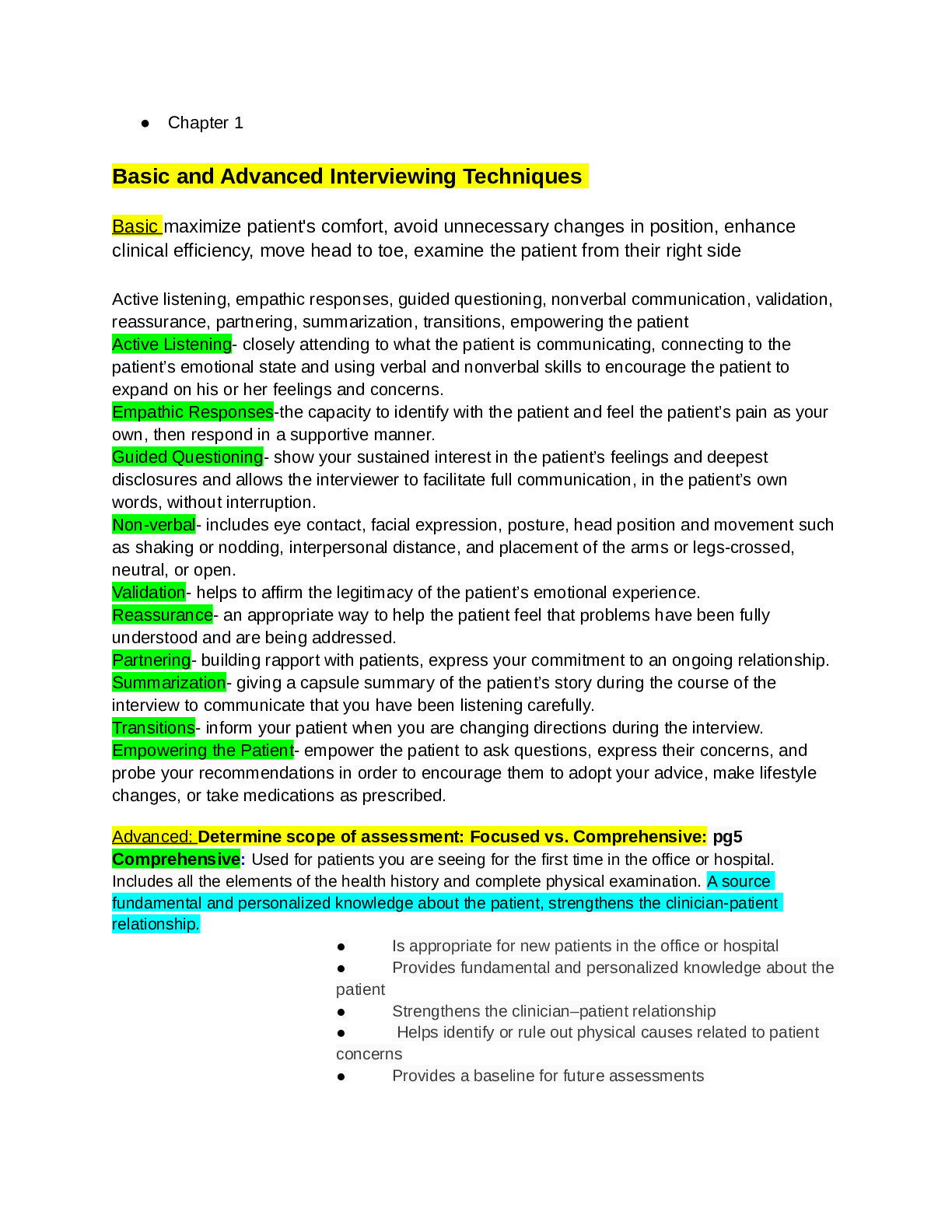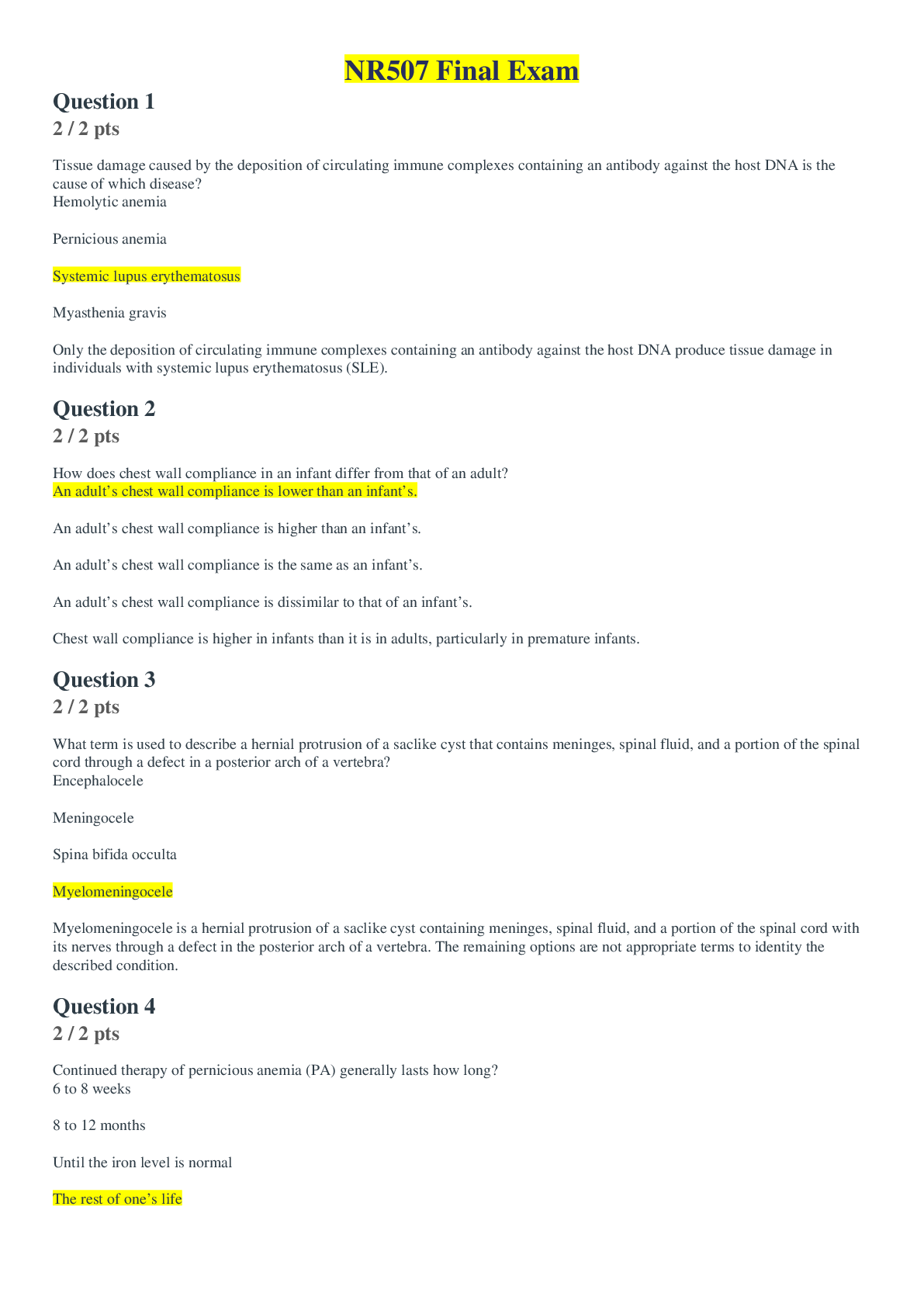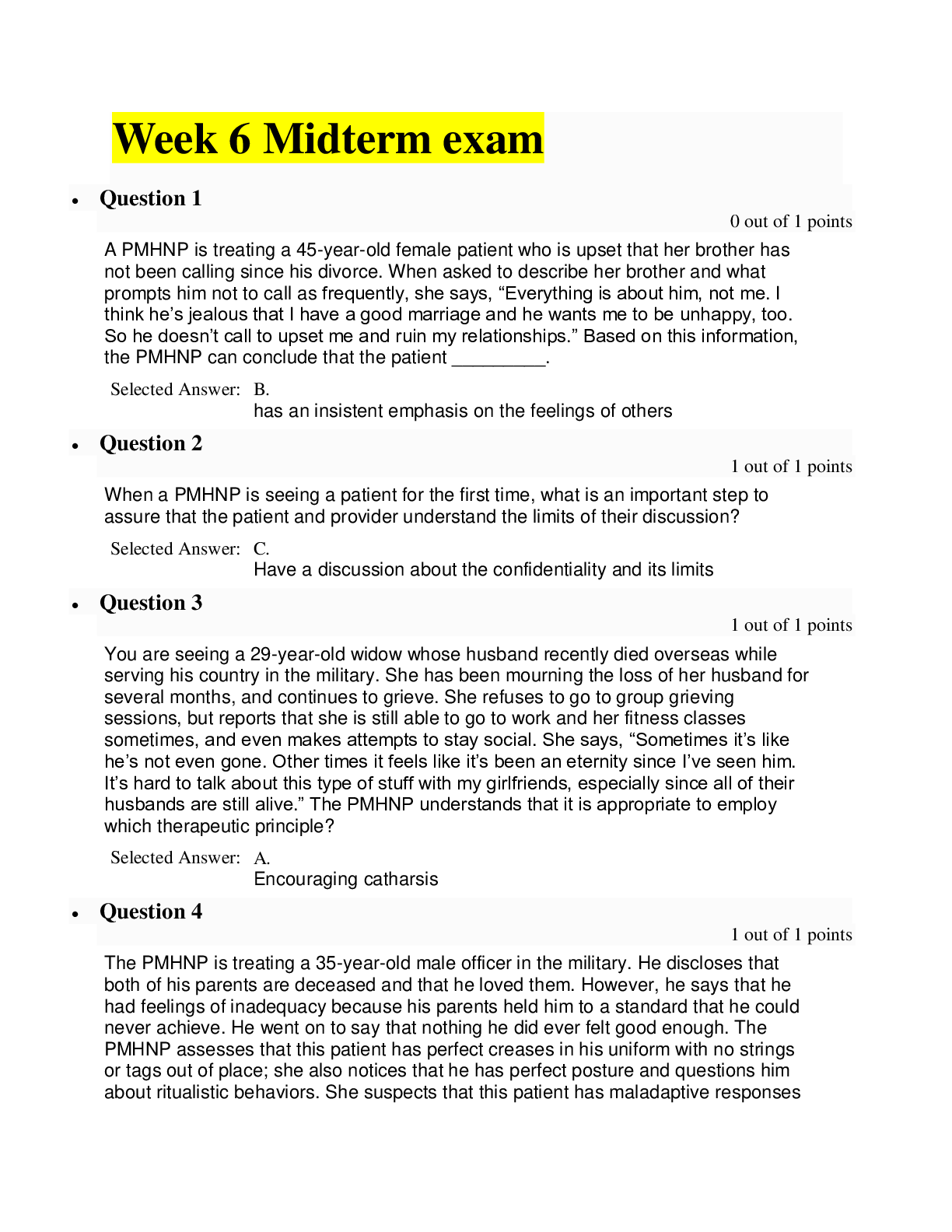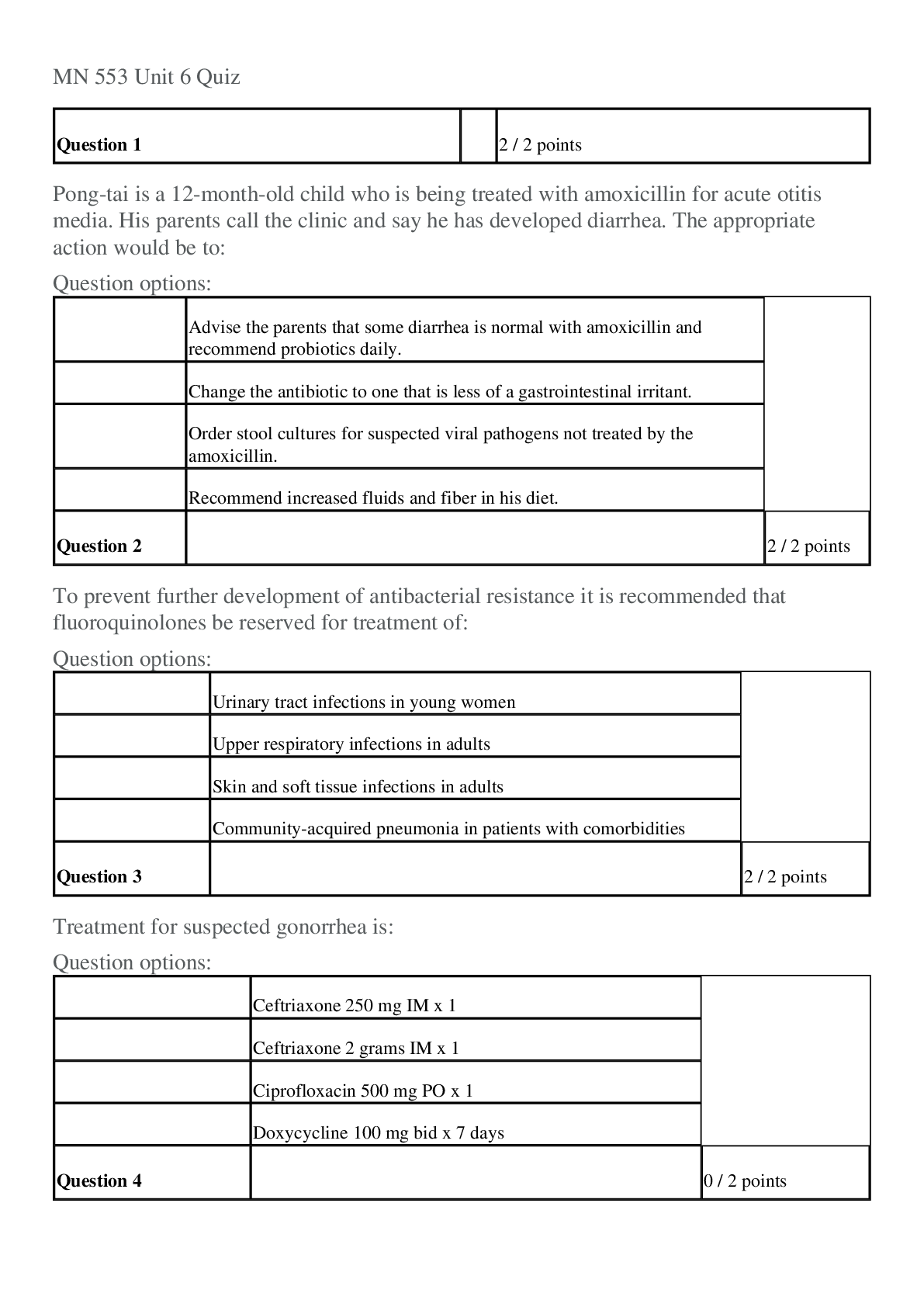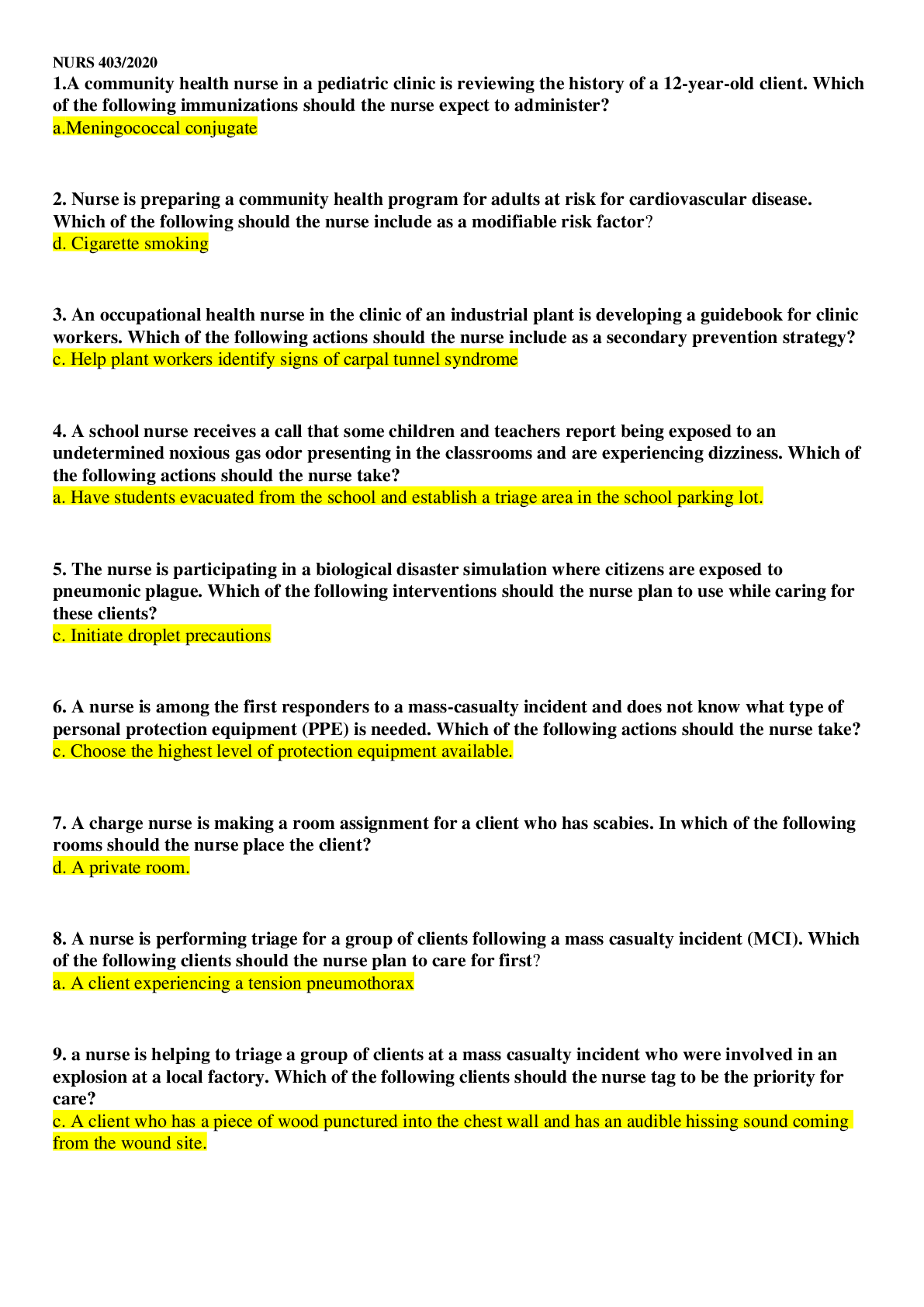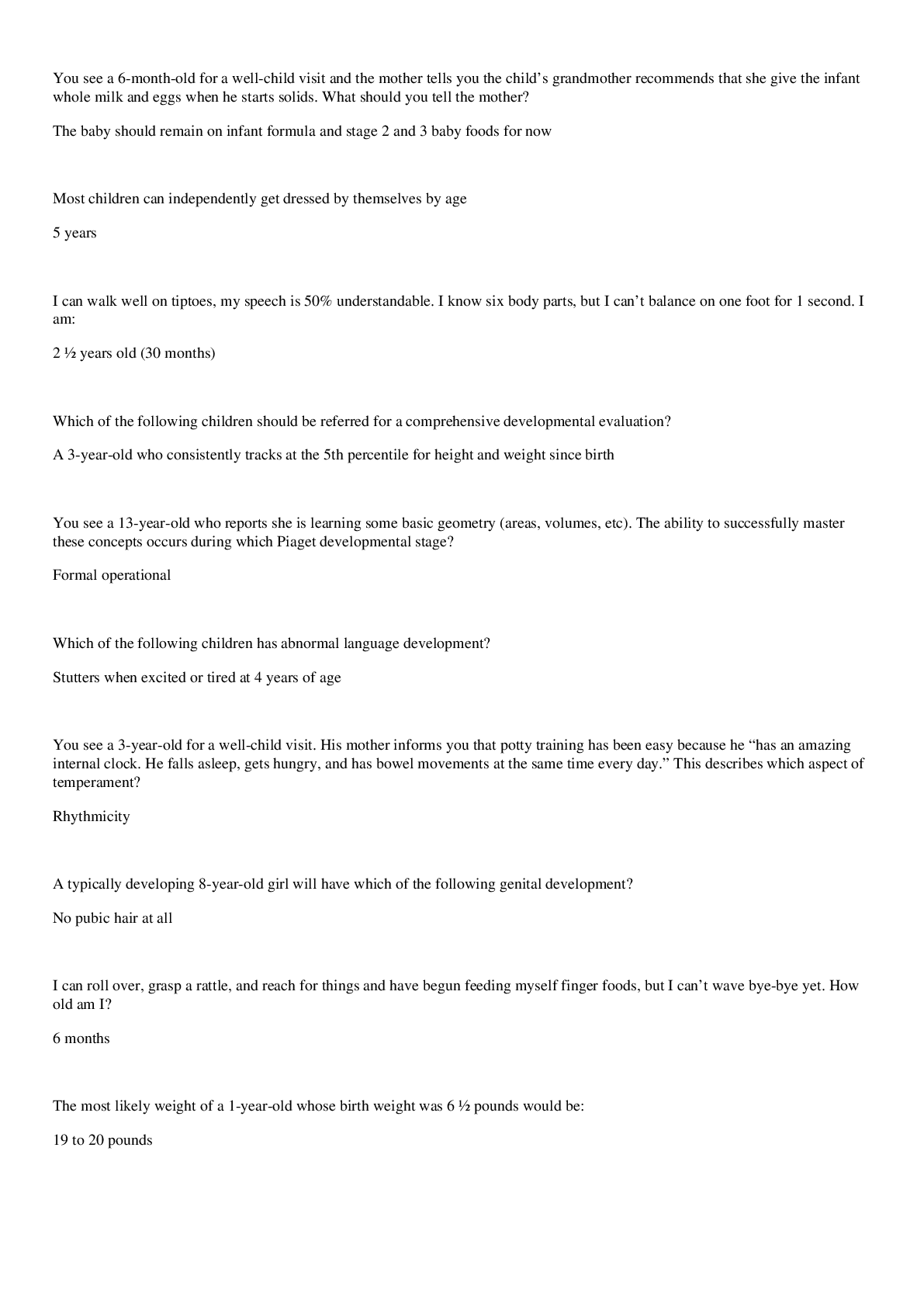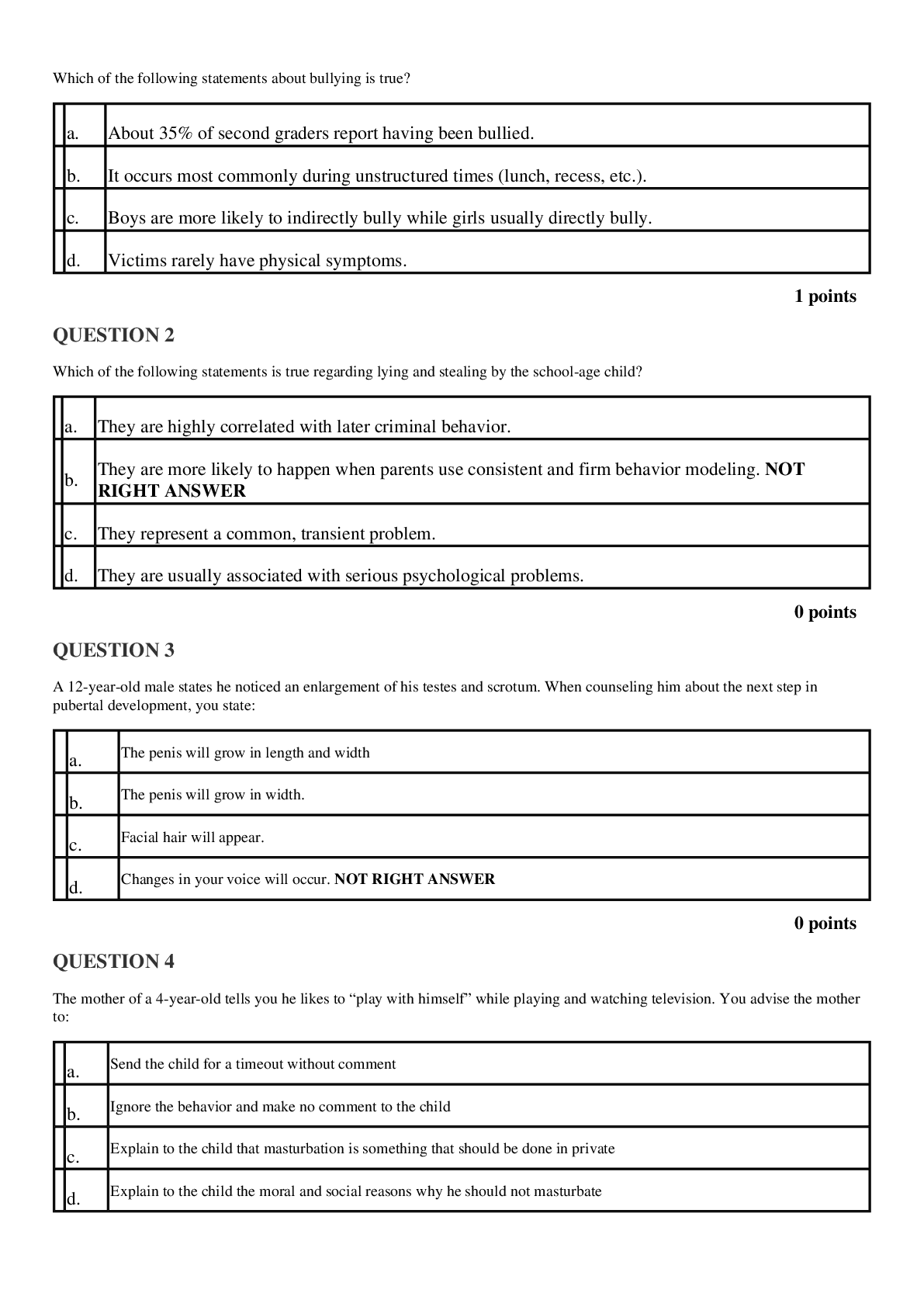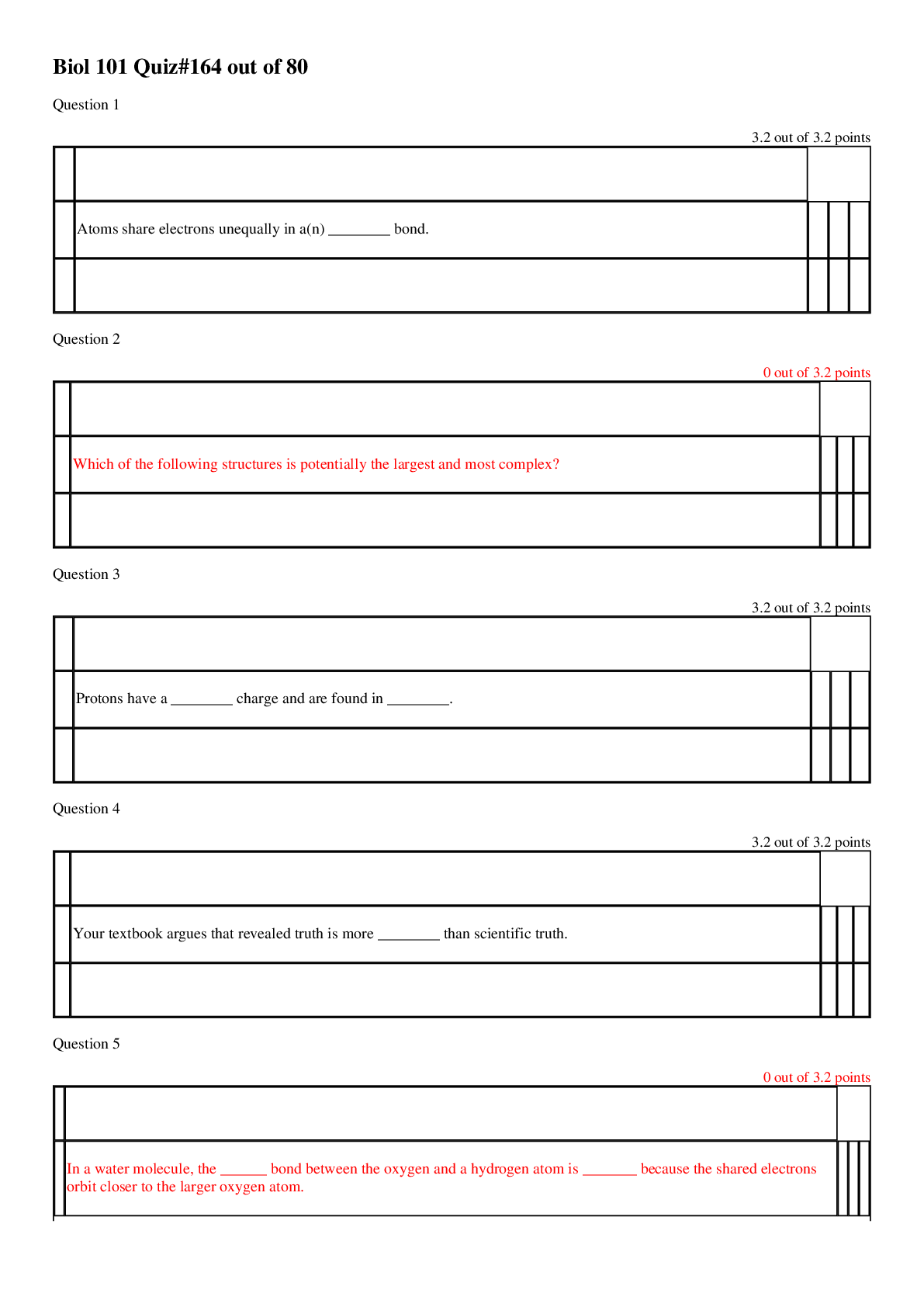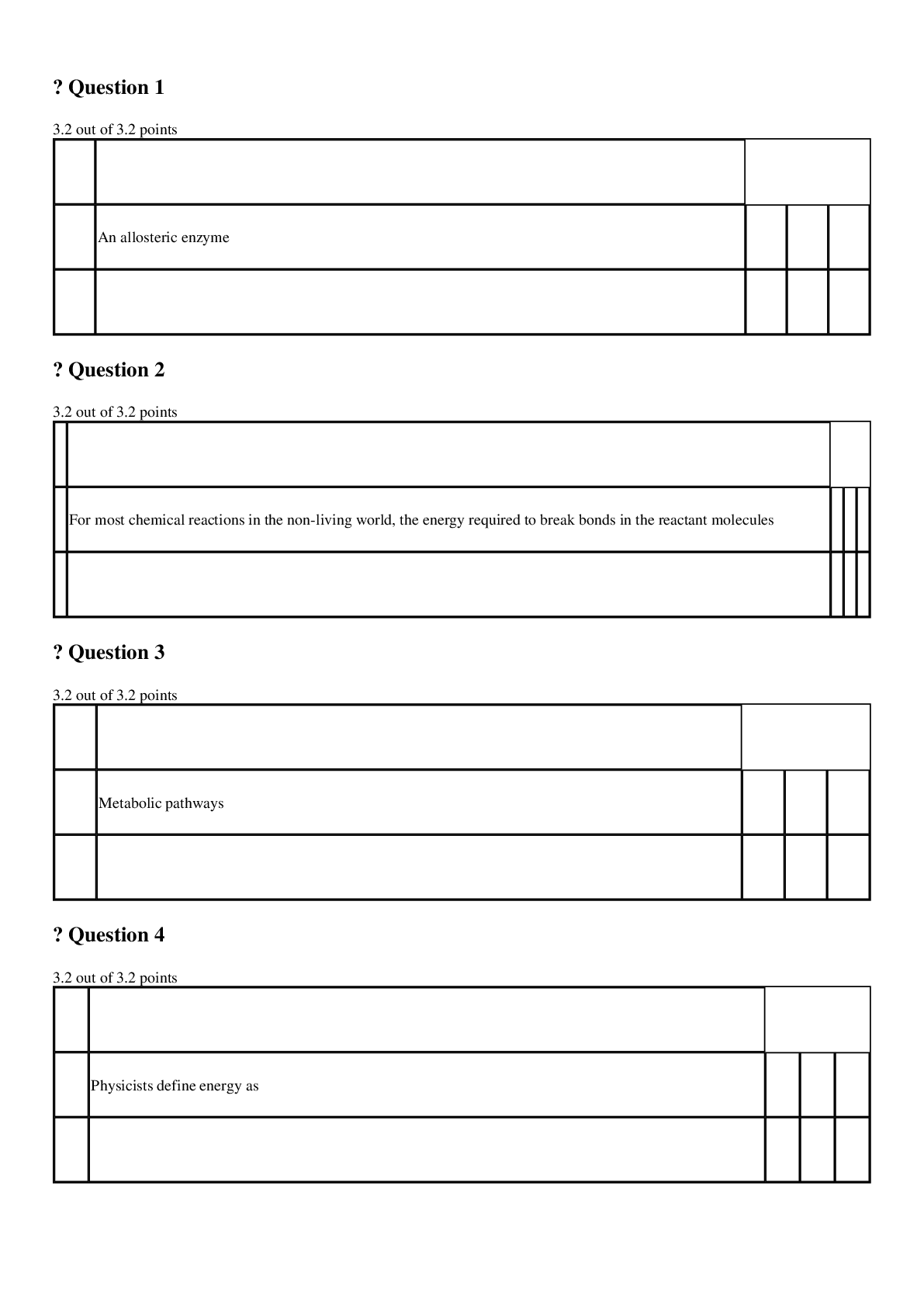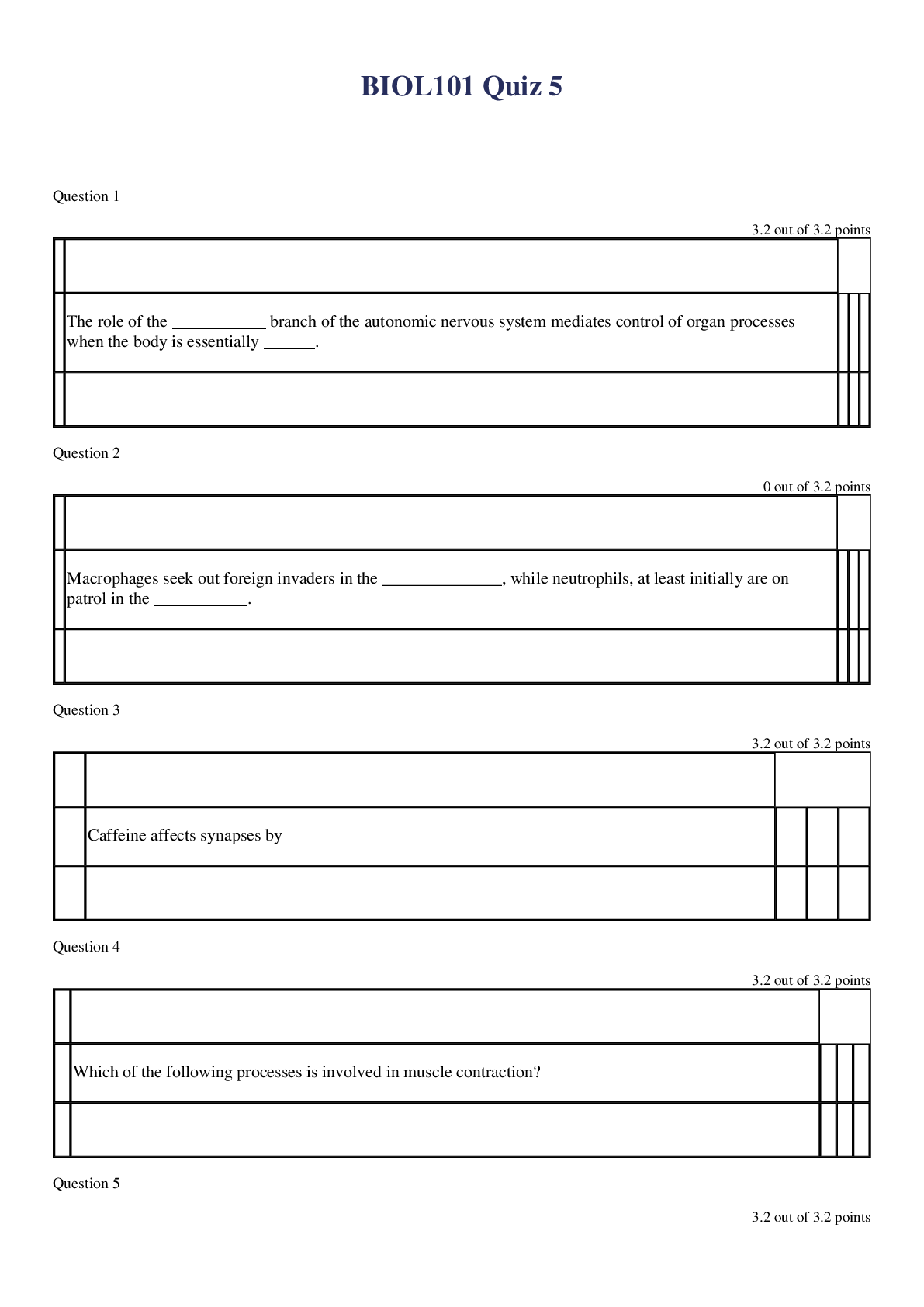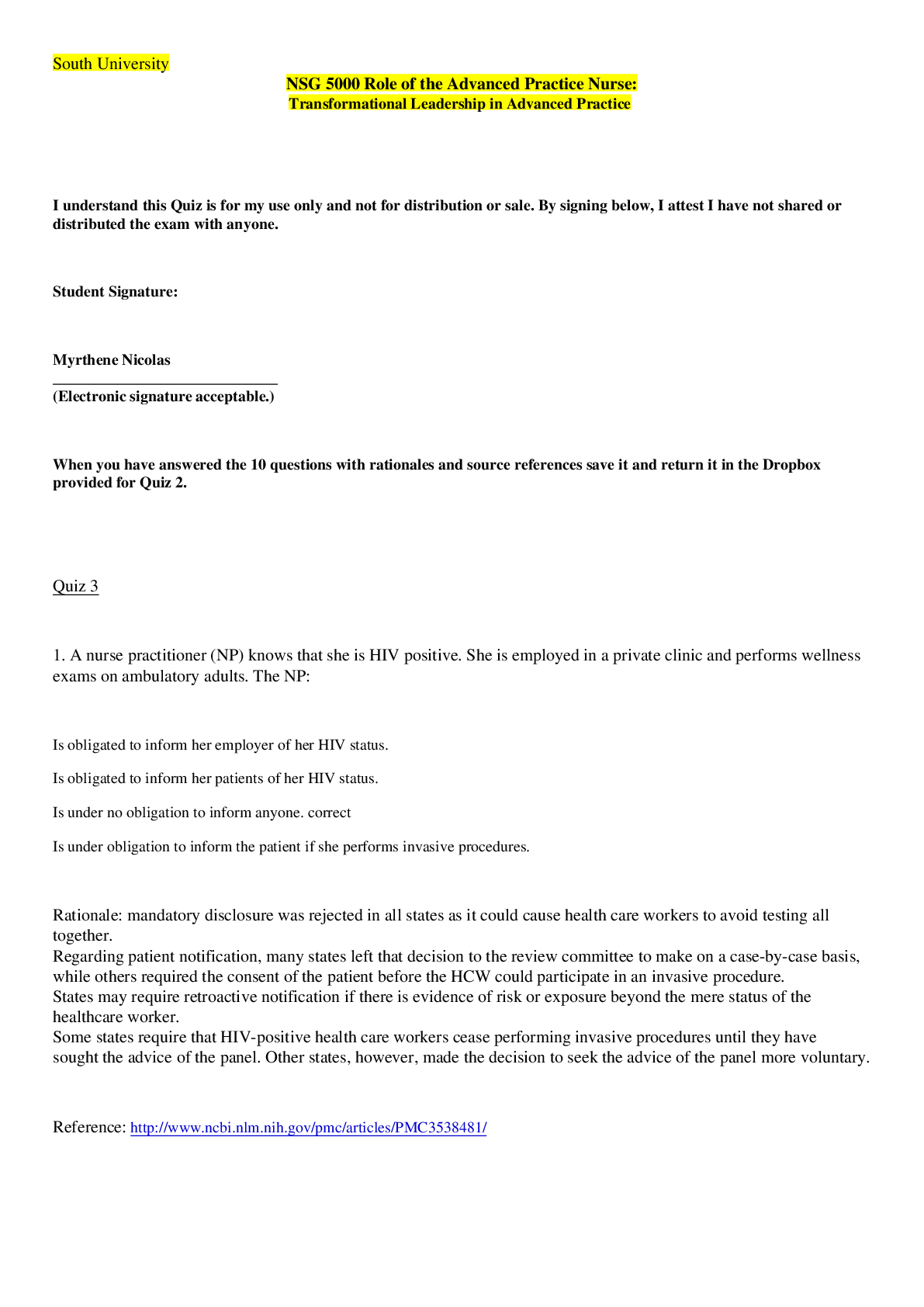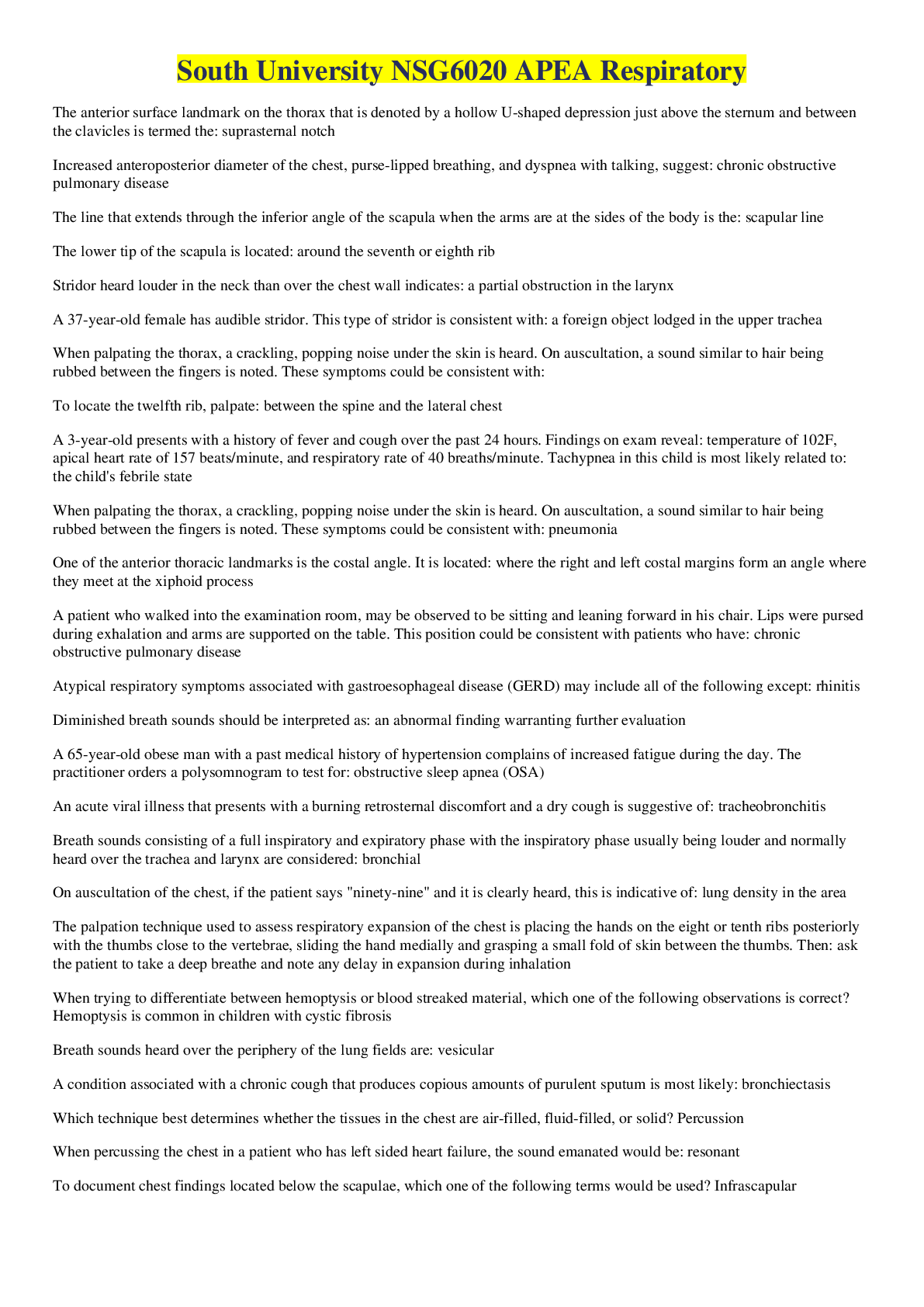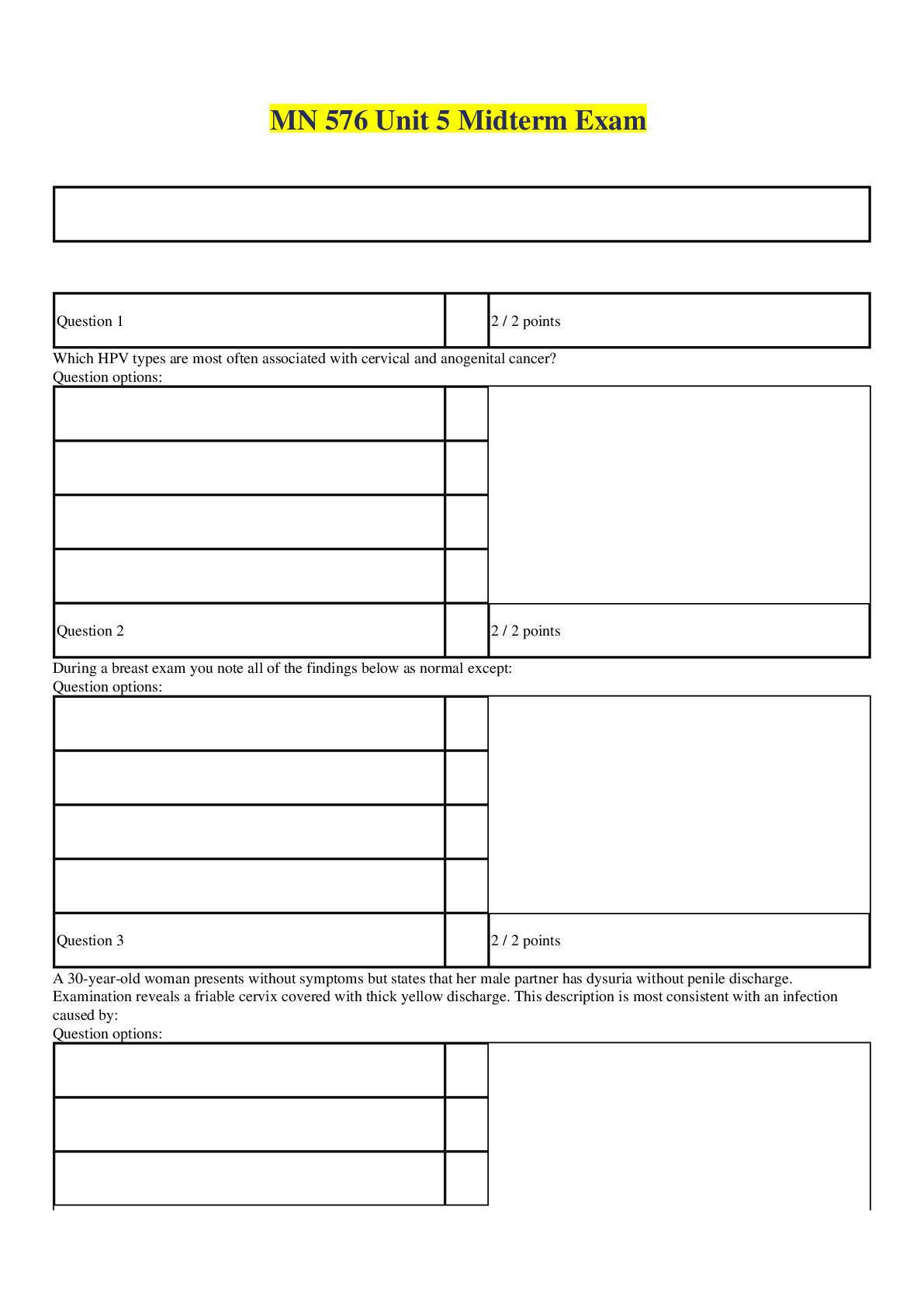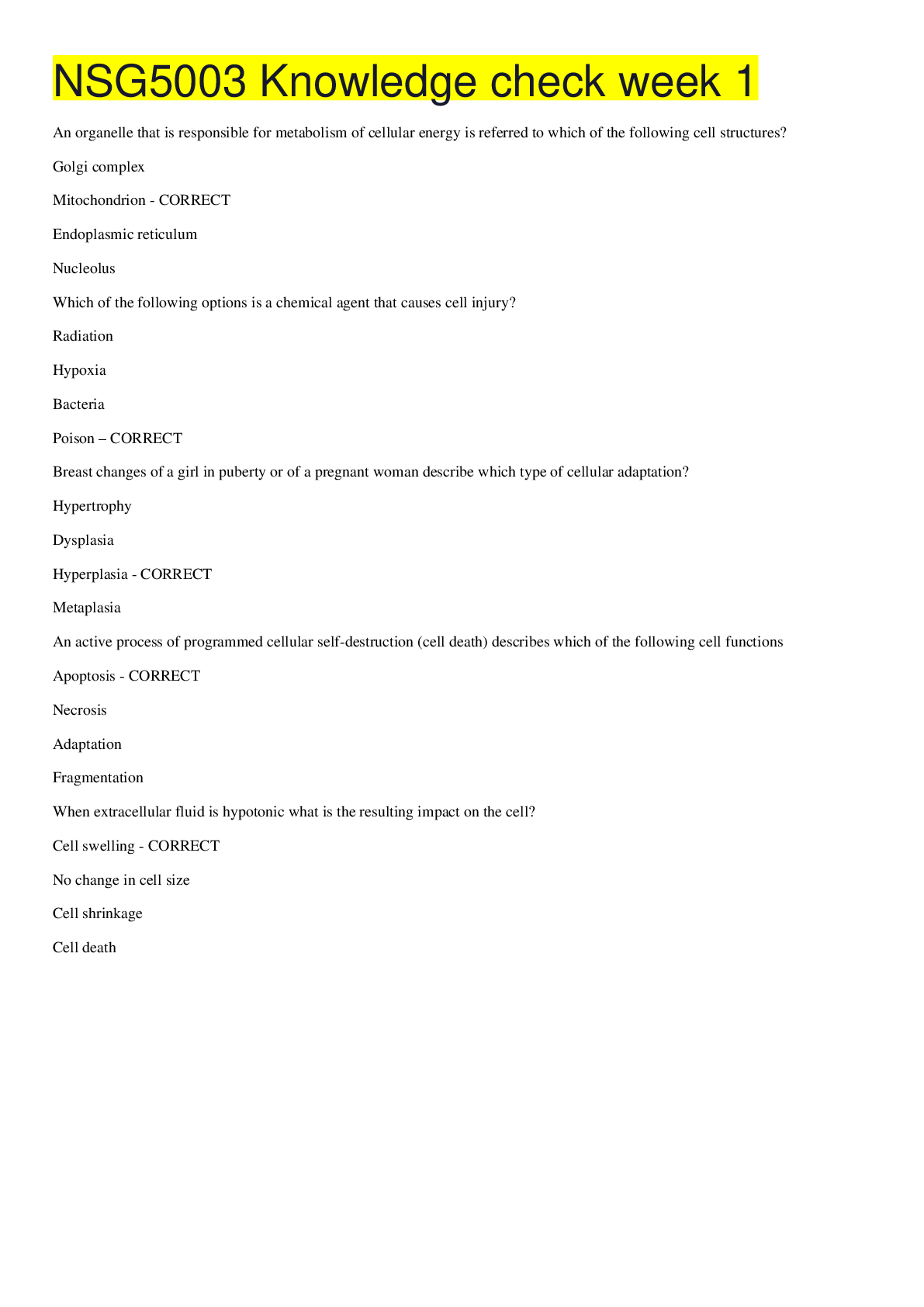*NURSING > EXAM > South University NSG6020 APEA Cardiovascular Disorders (Latest, 2020): ( Verified Answers by GOLD ra (All)
South University NSG6020 APEA Cardiovascular Disorders (Latest, 2020): ( Verified Answers by GOLD rated Expert, Download to Score A)
Document Content and Description Below
NSG6020 APEA Cardiovascular Disorders / NSG 6020 APEA Cardiovascular Disorders (Latest): South University South University NSG6020 APEA Cardiovascular Disorders (Latest) 1. In order to bring the ventr... icular apex closer to the chest wall when assessing the point of maximal impulse (PMI), ask the patient to: 2. The tonsillar, submandibular, and submental nodes drain the lymphatic fluid from portions of the: 3. When screening a patient for peripheral arterial disease (PAD), one risk factor would include a history of: 4. Heart sounds produced by turbulence due to a temporary increase in blood flow in predisposing conditions, such as hyperthyroidism, is considered: 5. A patient complains of a tight, bursting pain in the calf that increases with walking. Elevation of the leg sometimes relievesthe pain. These symptoms may be consistent with: 6. On assessment, which one of the following symptoms would be noted as a compensatory response to chronic hypoxia? 7. A patient describes chest pain as persistent, sharp, and knife-like. These symptoms are more characteristic of: pericarditis 8. The horizontal superficial inguinal lymph nodes are located in the anterior thigh below the inguinal ligament and drain lymphatic fluid from all of these areas except:testes 9. When assessing the heart rate of a healthy 13-month-old child, which one of the following sites is the most appropriate for this child? Apical pulse between the 3rd and 4th intercostal space in the left midclavicular line 10. To assess the murmur of aortic insufficiency, position the patient:sitting leaning forward 11. A child presents with fever of 102.5 F for the past five days.Kawasaki disease is suspected if which of the following groups of symptoms is present?Cervical lymphadenopathy, bilateral non-purulent conjunctivitis, periungual desquamation, and polymorphous rash 12. The great saphenous vein enters the deep venous system by way of the:femoral vein 13. A patient describes chest pain as pressing, squeezing, and tight lasting between 1 and 3 minutes. These symptoms are morecharacteristic of:myocardial infarction 14. A bruit heard in the epigastric area with both systolic and diastolic components is suggestive of:renal artery stenosis 15. Tissue ischemia is usually observed when assessing a patient with peripheral artery disease (PAD). What other symptom could be assessed?Intermittent claudication 16. A patient complains of some pain in the distal portions of her fingers on both hands.She states that it tends to occur more frequently with exposure to cold. These symptoms may be consistent with:Raynaud's disease 17. A patient presents with chest pain that radiates to the left side of the neck and down the left arm when he chops wood.This type of pain could be suggestive of:angina pectoris 18. The amplitude of the pulse in a patient in cardiogenic shock would most likely appear:thready 19. Characteristic symptoms of chronic venous insufficiency may include which one of the following?Petechiae leading to brown pigmentation noted over the feet 20. Children presenting with congenital heart defects that result in right to left shunting would most likely exhibit which of thefollowing symptoms?Cyanosis, decreased cardiac output, and desaturated systemic blood flow 21. The ankle-brachial index is a screening test used to assess a person's risk for:peripheral artery disease 22. A disease that may present as indigestion, but is precipitated by exertion and relieved by rest is most likely:angina 23. In order to assess for varicosities in the lower extremities, position the patient:standing 24. The four classic structural defects of Tetralogy of Fallot include:a ventricular septal defect, an overriding aorta, pulmonary stenosis, and right ventricular hypertrophy 25. A 68-year-old man with uncontrolled hypertension presents with sudden, intense left lower abdominal pain that radiates to the back. The pain is associated with a tearing sensation. These findings are MOST likely associated with:an abdominal aortic aneurysm (AAA) 26. Symptoms of orthostatic hypotension include all of the following except:respiratory rate greater than 30 27. When auscultating the heart, a scratchy, continuous murmur is audible during atrial systole and ventricular systole and diastole.This finding may be indicative of a:pericardial friction rub 28. In older adults, the presence of heart sound S4 suggests:hypertension 29. A patient with cirrhosis develops portal hypertension as indicated by the presence of:splenomegaly 30. The anterior cervical lymph node chain is located anterior and:superficial to the sternomastoid muscle 31. The axillary lymph nodes drain lymphatic fluid from all of the following areas except the:anterior chest wall 32. The lymphatic ducts drain into the:venous system 33. The patient has had an internal pacemaker in place for five years.Pacemaker failure is being considered because over the past few days, the patient has been experiencing episodes of:hiccoughs 34. Why would a newborn with patent ductus arteriosus receive a prostaglandin inhibitor (indomethacin)?To reduce fluid overload on the pulmonary circulation 35. In older adults, the presence of heart sound S3 suggests:heart failure 36. Enlarged or tender lymph nodes are most often associated with: infection in its nearby drainage area 37. Pain with walking or prolonged standing, radiating from the spinal area into the buttocks, thighs, lower legs, or feet, may be seen with: neurogenic claudication 38. A heart rate of 100-180 beats per minute in an adult is considered: sinus tachycardia 39. When auscultating the point of maximal impulse (PMI), apex of the heart, in an adult, the stethoscope is placed at the:fifth intercostal space to the left of the midclavicular line 40. When auscultating the heart, the displacement of the point of maximal impulse (PMI) is greater than 10 cm lateral to themidsternal line. This finding is consistent with:left ventricular hypertrophy 41. A finding suggestive of an inflamed lymph node would be one that is:tender and movable 42. The posterior auricular lymph nodes drain lymphatic fluid from the:posterior part of the temporoparietal region 43. Which of the following group of symptoms would be suggestive of an infant experiencing a congenital heart defect associated witha decreased pulmonary blood flow pattern?Tissue perfusion greater than 3 seconds, bluish colored skin, and poor feeding 44. What heart sounds are heard during auscultation of a man with Marfan syndrome who has a known mitral valve prolapse?A mid-systolic click 45. Deep cervical lymph nodes drain lymphatic fluid from the:head and neck 46. A patient complains of increased pain in the calf muscles and buttocks especially after walking or riding his bicycle.He states that the pain stops after he sits still for about 2-3 minutes. This condition may be associated with:intermittent claudication 47. A male patient states that he has difficulty breathing when he is lying down but when he sits up, it improves. This is a classicdescription of:orthopnea 48. The external iliac lymph nodes drain lymphatic fluid from the following areas except the:gluteal region 49. A disparity between the brachial and femoral pulses in a 4-month-old could indicate:coarctation of the aorta (COA) 50. The sacral lymph nodes receive lymphatic fluid from all the following except the:gluteal region 51. When auscultating the apex of the heart in an 8-year-old, the bell of the stethoscope should be placed at the:fifth intercostal space to the left of the midclavicular line 52. To auscultate the heart sounds arising from the pulmonic valve in an adult patient, place the stethoscope:between the 2nd and 3rd intercostal spaces at the left sternal border 53. Enlargement of which lymph nodes would be suggestive of metastasis from a thoracic or abdominal malignancy?supraclavicular 54. In an adult patient, auscultate the sounds arising from the mitral valve by placing the stethoscope:near the apex of the heard between the 5th and 6th intercostal spaces in the mid-clavicular line 55. Symptoms of acrocyanosis in the newborn include:bluish color of the feet 56. The anterior mediastinal lymph nodes drain lymphatic fluid from the:thymus, thyroid gland and the anterior part of the pericardium 57. When auscultating the heart for aortic insufficiency, ask the patient to:sit up, lean forward, and exhale 58. Presence of a heart murmur in a child would be considered organic if the child:was a 2-year-old with a congenital heart defect 59. A condition that usually presents with numbness or tingling in the distal portions of one or more fingers aggravated by cold oremotional stress may be associated with:Raynaud's disease 60. Right atrial pressure can be determined by:identifying the pulsations of the right jugular vein 61. While examining the heart, a pansystolic, blowing murmur is audible over the left sternal border with radiation to the right ofthe sternum. The intensity increased with inspiration. This finding is characteristic of:tricuspid regurgitation 62. While auscultating the patient's heart, a medium, soft murmur is audible.It is pansystolic and heard loudest at the apex with radiation to the left axilla. These findings are consistent with:mitral regurgitation 63. To assess aortic pulsations in patients with carotid obstruction, assess the pulse using the:brachial artery 64. A condition that presents with symptomatic limb ischemia upon exertion is termed:atherosclerotic peripheral vascular disease 65. Men between the ages of 40 and 64 years should be screened yearly for:hypertension 66. The thoracic lymph duct drains lymphatic fluid from all the following areas except the:right upper thorax 67. A patient complains of pain in the arch of the foot sometimes relieved by rest. Occasionally, he experiences intermittent painin the toes, especially at rest. Exercise aggravates the pain in the arch.History reveals he smokes approximately a half pack of cigarettes per day.These symptoms may be consistent with:thromboangiitis obliterans 68. When auscultating the heart of a 50-year-old patient, a soft murmur is audible in the left second and third intercostal spacesand radiates to the left shoulder and neck. Also noted is a crescendo-decrescendo pitch to the murmur. This finding could be consistent with: pulmonic stenosis 69. A sudden, tearing, sharp pain that begins in the chest and radiates to the back or into the neck is usually associated with:an aortic dissection 70. When auscultating heart sounds arising from the aortic valve in an adult patient, place the stethoscope:between the 2nd and 3rd intercostal spaces at the right upper sternal border 71. A twelve-month-old has a history of heart failure related to his congenital heart defect.He is receiving Aldactone (Spironolactone), enalapril (Vasotec), furosemide (Lasix), and acetaminophen (Tylenol).The infant'spotassium level is 3.1 meq/l. Which medication is most likely decreasing his potassium level?Furosemide (Lasix) 72. To auscultate the tricuspid valve heart sounds in an adult patient, place the stethoscope:between the 3rd, 4th, 5th, and 6th intercostal spaces at the left lower sternal border 73. The posterior auricular lymph node is located:superficial to the mastoid process 74. A 5-year-old child presents with complaints of fever and headache. Examination reveals a heart rate of 157 beats/minute,respiratory rate of 40 breaths/minute, B/P 108/54, and a temperature of 102.6F.The increased heart rate is most likely related to: the child's febrile state 75. When auscultating the heart of a 55-year-old patient, a loud murmur with a thrill is audible in the right second intercostalspace that radiates to the carotid arteries.Also noted is a crescendo-decrescendo pitch audible at the apex.The murmur is heard best with the patient sitting and leaning forward.This finding is consistent with:aortic stenosis 76. When auscultating the heart; S1 sound, is located at the apex of the heart and signifies:closure of the mitral and tricuspid valves 77. Which lymph nodes receive lymphatic fluid from the stomach, duodenum, liver, gallbladder, and pancreas?Hepatic lymph nodes 78. Pain or cramping of the legs that occurs during exertion and is relieved by rest is termed:intermittent claudication 79. A third heart sound (S3) is audible in a forty-five-year old. This S3 sound may be: a sign of valvular heart disease 80. When performing a cardiovascular assessment on a healthy 2-year-old child:auscultate the heart sounds in all four cardiac areas 81. Warning signs of peripheral artery disease may include all of the following except:persistent cough 82. A pediatric patient presents with erythema marginatum, chorea, and a heart murmur. These symptoms are consistent with:rheumatic heart disease 83. Causes of orthostatic hypotension in older adults may include all of the following except:impaired visual acuity 84. A three-week-old infant presents with a generalized lacy, reticulated blue discoloration of the skin. This is suggestive of:cutis marmorata 85. When assessing a 3-year-old African American child, the most likely cause of black, dusky mucous membranes is related to:cyanosis 86. The preauricular lymph node is located: in front of the ear 87. By placing the ball of the examiner's hand firmly on the chest, the examiner would be checking for: thrills 88. The hemodynamic changes resulting from structural defects in children can lead to heart failure. The most common reason for these changes is related to: volume and pressure overload resulting in decreased cardiac output 89. Assessment findings in a newborn at birth include: irregular respirations without crying, heart rate of 105 beats/minute, grimaces with reflex stimulation, kicking of both feet, and moving of both arms.The body and face are pink and hands and feet are cyanotic. What is the APGAR score? 7 90. A patient complaints of a sharp, knifelike pain that begins in the chest and radiates to the tip of the shoulder and to the neck. This type of chest pain is suggestive of:pericarditis 91. An otherwise healthy two-year-old presents with a heart rate that varies with inspiration and expiration. Which statement is true? This is a normal exam 92. The tonsillar lymph node is located: at the angle of the mandible 93. Widened pulse pressure (PP) is defined as systolic blood pressure (SBP):minus diastolic blood pressure 94. A widened pulse pressure greater than or equal to 60 in an older patient is a risk factor for cardiovascular disease, stroke, and: renal disease 95. Which of the following symptoms would necessitate the need for further evaluation in the newborn?Dusky cyanotic when crying 96. The occipital lymph node is located: at the base of the skull posteriorly 97. The preauricular nodes drain lymphatic fluid from the:palpebral conjunctiva and the skin adjacent to the ear within the temporal region 98. Absent or diminished pulses in the wrist could be indicative of:arterial occlusive disease 99. The posterior chest wall and portions of the arms are drained by which group of lymph nodes?subscapular nodes 100. A patient suspected of having chronic venous insufficiency, may present with: 101. The right lymph duct drains lymphatic fluid from all the following areas except the: 102. The infraorbital or maxillary, buccinator, and supramandibular lymph nodes drain lymphatic fluid from the: 103. Characteristic symptoms of chronic arterial insufficiency may include which one of the following? 104. A patient states that the only way he can sleep at night is to use several pillows or to sleep upright in a recliner.This sleep pattern is most consistent with: 105. The internal iliac lymph nodes drain lymphatic fluid from the: 106. The supraclavicular lymph nodes are located: 107. The superior and inferior mesenteric lymph nodes drain lymphatic fluid from the: [Show More]
Last updated: 1 year ago
Preview 1 out of 11 pages
Instant download
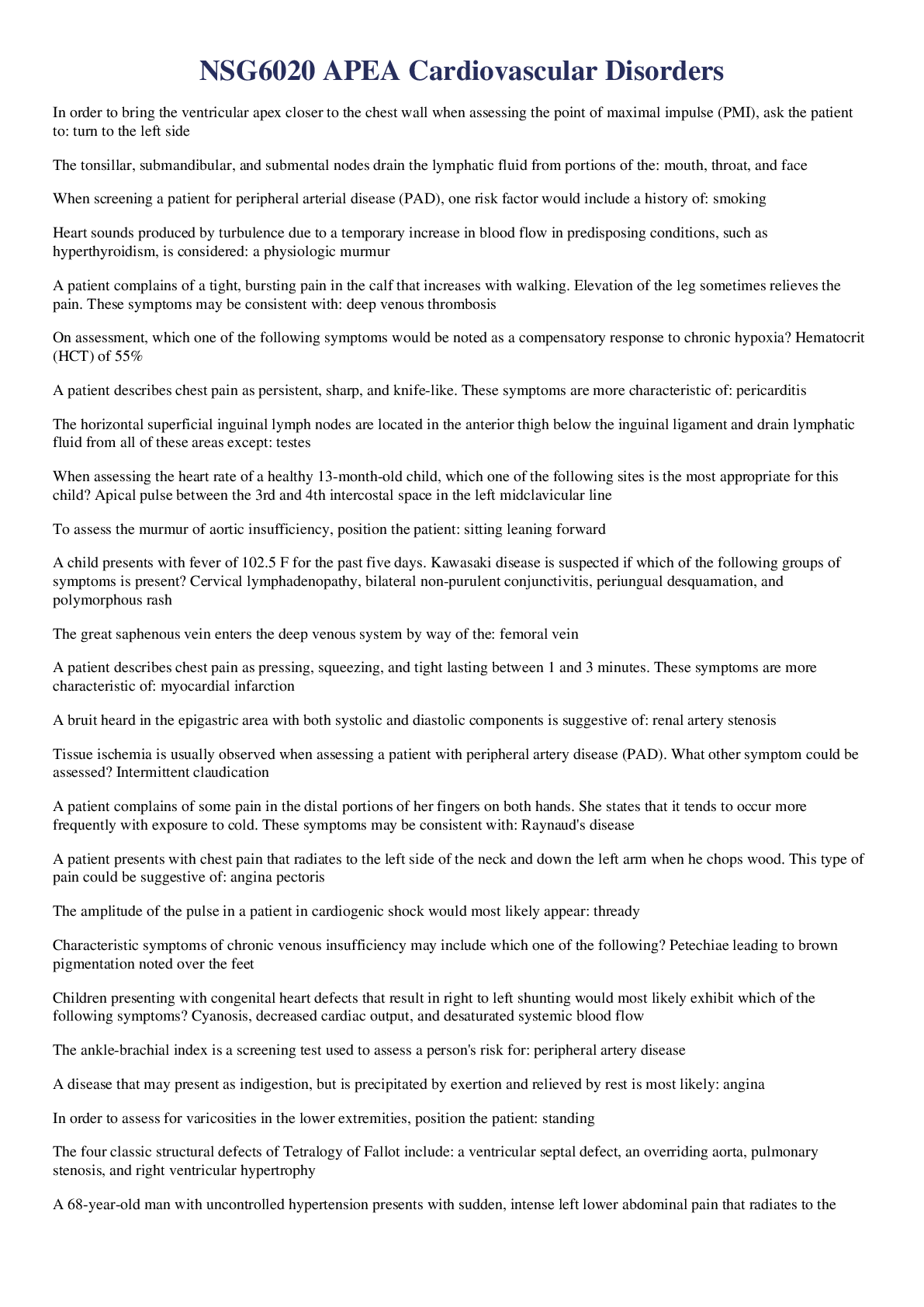
Buy this document to get the full access instantly
Instant Download Access after purchase
Add to cartInstant download
Reviews( 0 )
Document information
Connected school, study & course
About the document
Uploaded On
May 02, 2020
Number of pages
11
Written in
Additional information
This document has been written for:
Uploaded
May 02, 2020
Downloads
0
Views
38


